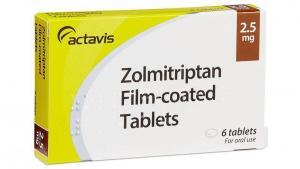 Zomig (Zolmitriptan): What Is It?
Zomig (Zolmitriptan): What Is It?
Zomig, also known as Zolmitriptan, is frequently prescribed to treat migraines. It is a member of the triptan medication class, which acts by constricting blood arteries in the brain and preventing the production of chemicals that aggravate migraines. Zomig offers individuals with varying needs or preferences during a migraine attack flexibility by being accessible in multiple formats, such as pills and nasal sprays. It’s not intended to be used as a preventative measure but to ease the acute symptoms of migraines. Like any medication, Zomig must be used under a doctor’s supervision and with regard to any potential drug interactions as well as particular health conditions.
Pharmacokinetics
After oral and intranasal dosages, Zolmitriptan has an approximate 40% absolute bioavailability. Depending on the formulation, peak plasma concentrations are reached 1.5–3 hours after oral doses and 3 hours after intranasal spray. About 25% of proteins bind to plasma. The hepatic metabolism of zolmitriptan results in the primary analogs of indole acetic acid, N-oxide, and N-desmethyl. In animal tests, the N-desmethyl metabolite (183C91) exhibited more activity than the parent molecule, suggesting that it may play a role in the therapeutic impact of Zolmitriptan.
Monoamine oxidase type A is in charge of the subsequent metabolism of the N-desmethyl metabolite, whereas cytochrome P450 isoenzyme CYP1A2 is primarily responsible for the primary metabolism of Zolmitriptan. About 30% of a dose ends up in the feces, mainly as the drug unaltered, and about 60% of a dose is eliminated in the urine, primarily as indole acetic acid. The elimination half-life is extended in people with liver illness and ranges from 2.5 to 3 hours. Research on rats has discovered distribution into milk.
Medical Research
Researchers at the Headache Care Center in Springfield, Missouri, synthesized the findings of three earlier studies to conclude that one 2.5 mg dose of Zolmitriptan, often known as Zomig, may offer long-term migraine relief.
The results, which were discussed at the Diamond Headache Clinic’s Headache Update ’99, examine the aggregated information from three distinct investigations. In every trial, subjects were compared between groups that received either Zolmitriptan (Zomig) or a placebo; nevertheless, the subjects’ pill identity remained a secret.
According to studies, people getting ready for work or school in the morning are most likely to experience migraines between six and seven a.m. For those who responded to the medicine, taking it between 6 and 9 a.m. relieved headaches for an average of 23 hours. The average length of alleviation for those who responded to the placebo was barely eight hours.
Within two hours of taking the medication, almost 60% of patients receiving a dose of 2.5 mg of Zolmitriptan experienced a favorable reaction. By comparison, only 22 to 39 percent of those receiving the placebo had good responses throughout that same period.
Regardless of the time of day a migraine occurs, the researchers found that Zolmitriptan, often known as Zomig, offers consistent, long-lasting relief.
According to the manufacturer, adults with acute migraines—with or without an aura—can benefit from taking this medicine. If you have ischemic heart disease, hypertension, or another severe cardiac problem, it is not advised.
Feelings of pressure, pain, and tightness or heaviness in many areas of the body, including the chest, are examples of side effects. During clinical studies, adverse effects were mild to moderate, with asthenia (weakness), nausea, and dizziness being the most common.
 Administration and Uses of Zolmitriptan
Administration and Uses of Zolmitriptan
A selective serotonin (5-HT1) agonist, zolmitriptan functions and is used similarly to sumatriptan. It is applied to treat migraine attacks acutely. Zolmitriptan is not recommended to prevent illness.
In the UK, 2.5 milligrams taken orally is the suggested dosage. One hour is all that is needed to expect a clinical response. If symptoms worsen or return within twenty-four hours, a second dose may be given no less than two hours after the initial dose. Subsequent episodes may be treated with doses of 5 mg if a patient does not receive adequate relief with a dose of 2.5 mg. Zolmitriptan has a maximum dose of 10 mg in 24 hours. In the United States, 1.25 or 2.5 mg is the recommended dose, with a maximum of 10 mg in 24 hours. Within fifteen minutes of intranasal administration, a clinical reaction is anticipated. One nostril should receive a single 5 mg dosage as is customary. A second dose, up to 10 mg daily, may be used after at least two hours if symptoms worsen or return within 24 hours.
People using specific other medications are advised to reduce their dosage. For patients receiving cimetidine or a monoamine oxidase type A inhibitor (although use with monoamine oxidase type A inhibitors is contraindicated in the USA), the maximum dose of Zolmitriptan in 24 hours should be 5 mg. For patients using medications that inhibit the cytochrome P450 isoenzyme CYP1A2, such as fluvoxamine and ciprofloxacin, a comparable reduction is advised. See below for dosage in cases of renal or hepatic impairment.
Using in Hepatic Disability
According to a study, patients with moderate or severe hepatic impairment do not require a reduction in the size of the initial zolmitriptan dose; however, patients with severe impairment may accumulate repeated doses, and their daily dosage should be lowered.
In the UK, licensed product information suggests a maximum oral dose of 5 mg in 24 hours for patients with moderate to severe impairment. A dosage of no more than 2.5 mg is advised in the USA.
Renal Impairment
Even while patients with moderate to severe impairment had lower renal clearance of Zolmitriptan and its metabolites, this impact was not thought to be clinically significant, and adjusting the dosage of Zolmitriptan in these patients was deemed unnecessary.
Headache and Cluster Migraine
See under sumatriptan for a comparison of the relative advantages of various triptans for migraine.
Side Effects and Safety Advice
Patients with Wolff-Parkinson-White syndrome or arrhythmias linked to accessory cardiac conduction channels should also refrain from using Zolmitriptan. Patients with moderate to severe hepatic impairment should use it cautiously.
Acute Ischemia
A 50-year-old lady has been reported to have had a spinal cord lesion associated with using Zolmitriptan; clinical characteristics indicated that the lesion was an ischemic infarct.
 Interactions
Interactions
For patients using cimetidine, it is advised to lower the maximum dosage of Zolmitriptan in 24 hours (see the Uses and Administration section). If Zolmitriptan is administered with medications that inhibit the cytochrome P450 isoenzyme CYP1A2, such as fluvoxamine and ciprofloxacin, a comparable dosage reduction is expected. Using Zolmitriptan with monoamine oxidase type A inhibitors, like moclobemide, is controversial. In the United Kingdom, the licensed product information suggests lowering the maximum dosage of Zolmitriptan when combined with monoamine oxidase type A inhibitors (see the Uses and Administration section). On the other hand, specific pairings are not recommended in the USA.
FAQ
How Does Zomig Work?
Zomig works by widening blood vessels surrounding the brain and lowering certain chemicals in the body to alleviate migraine symptoms such as light and sound sensitivity, headache pain, and nausea.
Which Forms Are There for Zomig?
There are various kinds of Zomig: tablets, orally disintegrating tablets, and nasal spray. Several variables, including the intensity of the migraine and individual preferences influence form selection.
How Soon Does Zomig Start Working?
Zomig usually begins to act between 30 minutes and 2 hours after being taken. The alleviation rate may differ depending on your circumstances and the type of Zomig you’re taking.
Single-ingredient Preparations
Argentina: Zomigon;
Australia: Zomig;
Austria: Zomig;
Belgium: Zomig;
Brazil: Zomig;
Canada: Zomig;
Czech Republic: Zomig;
Denmark: Zomig;
Finland: Zomig;
France: Zomig; Zomigoro;
Germany: AscoTop;
Greece: Zomigon;
Hong Kong: Zomig;
Hungary: Zomig;
Ireland: Zomig;
Israel: Zomig;
Italy: Zomig;
Mexico: Zomig;
Netherlands: Zomig;
Norway: Zomig;
Portugal: Zomig;
Russia: Zomig (Зомиг);
South Africa: Zomig;
Singapore: Zomig;
Spain: Flezol; Zomig;
Sweden: Zomig;
Switzerland: Zomig;
Thailand: Zomig;
United Kingdom: Zomig;
United States: Zomig;
Venezuela: Zomig



































